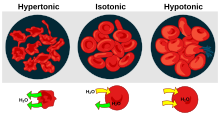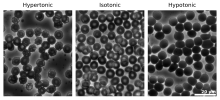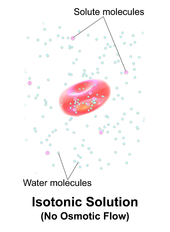what is the tonicity of normal saline compared to blood

Effect of unlike solutions on reddish blood cells

Micrographs of osmotic pressure level on cherry blood cells
Tonicity is a measure of the constructive osmotic force per unit area gradient; the water potential of two solutions separated by a partially permeable cell membrane. Tonicity depends on the relative concentration of selective membrane impermeable solutes beyond a cell membrane which determine the direction and extent of osmotic flux. It is ordinarily used when describing the swelling versus shrinking response of cells immersed in an external solution.
Unlike osmotic pressure, tonicity is influenced simply by solutes that cannot cross the membrane, as simply these exert an effective osmotic pressure. Solutes able to freely cross the membrane practice not affect tonicity because they will always equilibrate with equal concentrations on both sides of the membrane without internet solvent movement. It is as well a factor affecting imbibition.
There are three classifications of tonicity that one solution tin can accept relative to another: hypertonic, hypotonic, and isotonic.[1]A hypotonic solution case is salt h2o.
Hypertonic solution [edit]

A red blood cell in a hypertonic solution, causing h2o to move out of the prison cell.
A hypertonic solution has a greater concentration of non-permeating solutes than another solution.[2] In biological science, the tonicity of a solution unremarkably refers to its solute concentration relative to that of some other solution on the reverse side of a cell membrane; a solution outside of a prison cell is called hypertonic if it has a greater concentration of solutes than the cytosol inside the jail cell. When a cell is immersed in a hypertonic solution, osmotic pressure level tends to force water to flow out of the cell in guild to remainder the concentrations of the solutes on either side of the cell membrane. The cytosol is conversely categorized equally hypotonic, opposite of the outer solution.[3] [4]
When plant cells are in a hypertonic solution, the flexible cell membrane pulls abroad from the rigid cell wall, merely remains joined to the cell wall at points called plasmodesmata. The cells often take on the appearance of a pincushion, and the plasmodesmata almost cease to function because they become constricted, a condition known as plasmolysis. In plant cells the terms isotonic, hypotonic and hypertonic cannot strictly be used accurately because the pressure exerted by the jail cell wall significantly affects the osmotic equilibrium indicate.[5]
Some organisms take evolved intricate methods of circumventing hypertonicity. For instance, saltwater is hypertonic to the fish that alive in it. Because the fish demand a big surface surface area in their gills in contact with seawater for gas exchange, they lose water osmotically to the sea from gill cells. They respond to the loss by drinking big amounts of saltwater, and actively excreting the excess salt.[half dozen] This procedure is called osmoregulation.[7]
Hypotonic solution [edit]

A cerise blood prison cell in a hypotonic solution, causing water to movement into the cell.
A hypotonic solution has a lower concentration of solutes than another solution. In biology, a solution outside of a cell is called hypotonic if it has a lower concentration of solutes relative to the cytosol. Due to osmotic pressure, water diffuses into the cell, and the cell frequently appears turgid, or bloated. For cells without a cell wall such as creature cells, if the slope is large plenty, the uptake of excess water tin produce enough force per unit area to induce cytolysis, or rupturing of the cell. When plant cells are in a hypotonic solution, the central vacuole takes on extra h2o and pushes the cell membrane against the cell wall. Due to the rigidity of the cell wall, it pushes back, preventing the cell from bursting. This is called turgor pressure.[8]
Isotonicity [edit]

A solution is isotonic when its effective osmole concentration is the same equally that of another solution. In biology, the solutions on either side of a jail cell membrane are isotonic if the concentration of solutes outside the cell is equal to the concentration of solutes inside the cell. In this case the cell neither swells nor shrinks because in that location is no concentration gradient to induce the diffusion of large amounts of water beyond the cell membrane. H2o molecules freely diffuse through the plasma membrane in both directions, and as the rate of water diffusion is the same in each direction, the cell volition neither gain nor lose water.
An iso-osmolar solution can exist hypotonic if the solute is able to penetrate the cell membrane. For case, an iso-osmolar urea solution is hypotonic to red blood cells, causing their lysis. This is due to urea entering the cell down its concentration slope, followed by water. The osmolarity of normal saline, nine grams NaCl dissolved in water to a total volume of one liter, is a shut approximation to the osmolarity of NaCl in claret (about 290 mOsm/50). Thus, normal saline is almost isotonic to blood plasma. Neither sodium nor chloride ions tin can freely pass through the plasma membrane, unlike urea.
See also [edit]
- Osmotic concentration
- Osmosis
- Salinity
References [edit]
- ^ Sperelakis, Nicholas (2011). Cell Physiology Source Volume: Essentials of Membrane Biophysics. Bookish Press. p. 288. ISBN978-0-12-387738-three.
- ^ Buckley, Gabe (twenty Jan 2017). "Hypertonic Solution". In Biologydictionary.net (ed.). Biology Dictionary (Online ed.). Biologydictionary.cyberspace. Retrieved 19 Baronial 2021.
- ^ LibreTexts Projection: Medicine (xviii July 2018). "iii.3C - Tonicity". Anatomy and Physiology (Boundless) (Online ed.). med.libretexts.org/. Retrieved 19 August 2021.
- ^ Argyropoulos, Christos; Rondon-Berrios, Helbert; Raj, Dominic S; Malhotra, Deepak; Agaba, Emmanuel I; Rohrscheib, Mark; Khitan, Zeid; Murata, Glen H; Shapiro, Joseph I.; Tzamaloukas, Antonios H (2 May 2016). "Hypertonicity: Pathophysiologic Concept and Experimental Studies". Cureus. viii (5): e596. doi:ten.7759/cureus.596. PMC4895078. PMID 27382523.
- ^ Lodish, Harvey; Berk, Arnold; Zipursky, S. Lawrence; Matsudaira, Paul; Baltimore, David; Darnell, James (2000). "Osmosis, H2o Channels, and the Regulation of Cell Volume". Molecular Cell Biology (4th ed.). New York: W. H. Freeman and Company. Retrieved 19 Baronial 2021.
- ^ Soult, Allison (2020). "8.4 - Osmosis and Improvidence". In University of Kentucky (ed.). Chemical science for Allied Health. Open up Education Resource (OER) LibreTexts Project. Retrieved 19 Baronial 2021.
- ^ Ortiz, RM (June 2001). "Osmoregulation in marine mammals". The Journal of Experimental Biology. 204 (Pt eleven): 1831–44. doi:x.1242/jeb.204.11.1831. PMID 11441026.
- ^ "Definition — hypotonic". The Free Dictionary. Retrieved 23 August 2012.
Source: https://en.wikipedia.org/wiki/Tonicity
0 Response to "what is the tonicity of normal saline compared to blood"
Post a Comment